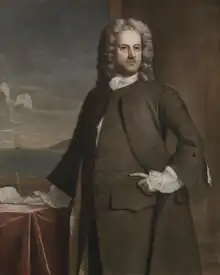
Charles Apthorp (March 1697 – November 1758) was an English-born merchant and slave trader in Boston, Massachusetts. Apthorp managed his import business from Merchants Row, and "in his day he was called the richest man in Boston." He also served in the employ of the British government for various schemes it attempted to implement in North America.[1][2]
Early life
Charles Apthorp was baptised on 28 March 1697 at St Botolph-without-Bishopsgate, London, England, to East Apthorp and Susan Ward.
Career
Charles Apthorp emigrated with his parents to New England some time after 1698. In 1713 his father died in Boston. In the city, he served as a commissary and paymaster for the British Army and established a mercantile business.[3][4][5] Apthorp was a successful, wealthy man, with "imperial trading connections".[3][6]
Import merchant
Among the goods imported and/or sold through Apthorp on Merchants Row in Boston were "choice madera wines, ... a parcel of Russia duck and several sorts of European goods";[7] "British duck of all sorts";[8] "choice good sea coal, ... several second hand cables, little the worse for wear, and anchors suitable, with window glass of most sorts, and a parcel of lead and shot";[9] "a good new still and worm of about 600 gallons";[10] salt;[11] "a parcel of guns, 4-pounders, with carriages and shott, also a parcel of swivel-guns with shott suitable;"[12] a "well fitted" 50-ton sloop";[13] and "a brigantine about 90 tuns, and three years old, now lying at the Long Wharfe".[14]
Slave trade
Apthorp was a "venerable slave importer and one of the richest men in Boston" by 1746. At that time, slave advertisements regularly appeared in the weekly Boston Gazette. Between 1719 and 1781, there were about 2,300 slave advertisements for about 2,000 enslaved individuals.[15] In the 1730s and 1740s he traded in slaves, posting advertisements in Boston Gazette, which one stating that he had "a parcel of likely negros just imported".[16][17]
In 1733 Apthorp acted as agent for a man seeking his enslaved servant, Hannah Smyth, who had run away with a stolen diamond "and has lately been seen here in Boston."[18] He performed a similar role in 1742, authorized to furnish "five pounds reward" for the return of a "negro man named Jack about 35 years old" to his enslaver, Stephen Eastwick.[19] In 1756 Apthorp & Son served as agent for someone looking for an anchor lost on Cape Cod "with two iron clasps on one of the flukes, a solid pine buoy, and buoy-rope."[20]
British government representative
Along with Thomas Hancock, Apthorp represented the British government in its efforts to recruit personnel to Nova Scotia—ship pilots, bricklayers, carpenters, settlers, etc.[21][22][23][24] He also served as "paymaster and commissary under the British Government of the land and naval forces quartered in Boston".[4]
Apthorp and Hancock also supplied many of the ships used during the forced removal of the Acadians from Nova Scotia. The two merchants also lent money to finance the operation, and the poor quality of ships supplied by Apthorp and Hancock led to instances of malnutrition, disease and death among the Acadians on board.[25]
Personal life
Marriage and children
Apthorp married Grizzel Eastwicke on 13 January 1726. She was born in Jamaica to Griselda Lloyd and John Eastwicke.[4][26][nb 1] A descendant of the couple, great-grandson Joseph Coolidge, stated that: "Her portrait, painted by Sir Peter Lely, and showing her to have been remarkably beautiful, remains in the family."[26] She was said to have "rare qualities of person and character."[3]
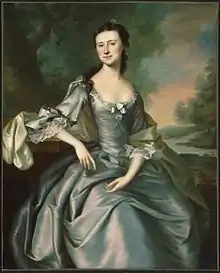
Apthorp and his wife had eighteen children, three whom died before him.[4] The children included:[nb 2]
- Charles Ward Apthorp (later of Apthorp Farm).[28] Charles married Mary McEvers.[5] His granddaughter was Maria Eliza Van Den Heuvel, who married John Church Hamilton. His great granddaughter, Charlotte Augusta Gibbes, married John Jacob Astor III.
- Grizzel married Barlow Trecothick.[5]
- Susan married Thomas Bulfinch on 8 October 1754. He was warden of the King's Chapel church after the Revolutionary War.[5] They were the parents of architect Charles Bulfinch.
- John married 1st Alica Mann, sister of Horace Mann, 2nd Hannah Greenleaf daughter of Stephen Greenleaf, granddaughter of Thomas Loring. He was member of the house of Thomlinson and Trecothink. On a voyage to Charleston, South Carolina, they were lost at sea. Their children survived them, Colonel John T. Apthorp, Hannah who married Charles Bulfinch, and Frances who married Charles Vaughn.[5]
- James was born 17 November 1731 and married Sarah Wentworth. Her family owned Wentworth Manor in Yorkshire.[5]
- East, who became a minister.[5][28] East Apthorp built in 1761 a mansion designed by Peter Harrison; it is now part of the Harvard University campus in Cambridge, Massachusetts.[29]
- Ann, born 18 January 1735 – 1736. She married Nathaniel Wheelwright.[5]
- Henry (19 March 1736 – 1762)[5]
- Stephen born 10 March 1737 – 1738[5]
- Joseph (22 April 1739 – March 1749 – 1750)[5]
- Elizabeth born 28 May 1740. She was married twice to men from New York: James McEvers (her eldest brother's brother-in-law), and her brother-in-law Robert Bayard, after her sister Rebecca's death.[5]
- Thomas born 19 October 1741. After his father's death and until 1776, Thomas was made paymaster to British forces. He went to England, married in Lisbon and died in Ludlow, Wales.[5]
- Rebecca born 20 June 1746. She married Robert Bayard from New York.[5]
- William born 26 February 1749. He married Mary Thompson.[5]
There were also three children born between 1742 and 1745 who died as young children: Catherine, George, and Robert. A second daughter Catherine was born in 1750; She died on the date of her birth.[5]
The family had a home in Boston and another outside town in Quincy, Massachusetts.[3]
Religion
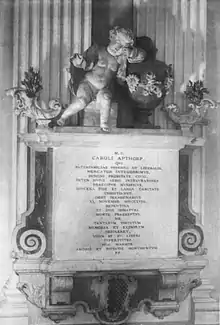
He helped to found Trinity Church, Boston[3] and was one of the first churchwardens of that church.[4]
He was a churchwarden at the King's Chapel in Boston,[4] starting in 1731 when he and other churchwardens met weekly and conducted affairs for the church, including hiring, assigning pews in the church, managing finances and interacting with members about church operations. Apthorp, "of the old tenor, contributed £200 towards the cost of a new church building; If sufficient funds were not raised within the church congregation, he agreed to pay an additional £1,000. He was elected to manage treasury of the new building funds.[4][30]
He was a leading, "noteworthy" member of the church who was: "Warden in 1731-1732, 1743-1744, treasurer of the Building Committee, and a generous subscriber to the new church.[26][31]
His large family filled two family pews in the church.[5]
Among the Apthorp's personal possessions were "a set of eight chairs ... probably purchased from the chairmaker and upholsterer Samuel Grant, [with] carving ... attributed to John Welch."[32]
Portraits
Portraits were made of Charles Apthorp by Joseph Blackburn;[33][nb 3] and John Singleton Copley.[33]
Family portraits at the Museum of Fine Arts, Boston as of 1908 include works by Robert Feke and Hartwell:[34][35][36][nb 4]
- Portrait of Charles Apthorp, by Robert Feke
- Portrait of Griselda Eastwicke Apthorp, by Robert Feke
- Portrait of Mrs. Barlow Trecothick, by Robert Feke
- Portrait of Griselda Eastwicke, by Hartwell
The Fine Arts museum's collection now contains miniatures, a few portraits and silverware from the Apthorp family.[37]
Death
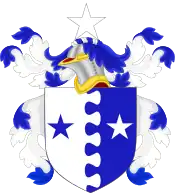
Apthorp died suddenly in November 1758; he complained "of a slight cold a few minutes before he expired."[4][5][38] A New England newspaper described him as "the greatest and most noble merchant on this continent." Twelve days after his death, his funeral was held at King's Chapel.[4] It was "attended by very many gentlemen of distinction and principal inhabitants of the town. The streets and windows of the houses, as the solemnity passed along, were thronged with spectators. ... [At King's Chapel] the Reverend Mr. Caner preached a suitable sermon to a crowded audience."[39]
A wall monument sculpted by Henry Cheere and shipped from England, memorializes Apthorp inside King's Chapel; it "is crowned by a cherub weeping over a cinerary urn."[40][41]
In a book written in 1910, Apthorp left a fortune equal to $150,000.[3]
After her husband died Grizzel lived near the Central House on Brattle Square [Dock Square at Brattle Street].[3] She died at 88 years of age in 1796 in the home of her son, John in Quincy. A notice of her death described her as virtuous, amiable, charitable and well-regarded.[42]
Images
 Newspaper advertisement, 1732, seeking his lost copy of Clarendon's History of the Rebellion
Newspaper advertisement, 1732, seeking his lost copy of Clarendon's History of the Rebellion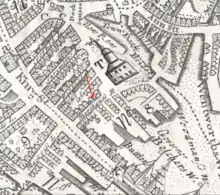 Detail of 1743 map of Boston, showing Merchants Row
Detail of 1743 map of Boston, showing Merchants Row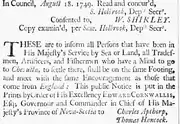 Newspaper item encouraging British settlement in Chebucta, Nova Scotia, 1749
Newspaper item encouraging British settlement in Chebucta, Nova Scotia, 1749
See also
References
Notes
- ↑ Griselda's father was Sir John Lloyd of Somersetshire, England. After the Battle of Worcester, Lloyd was one of the men who escorted King Charles II of England to France.[4]
- ↑ Among his grandchildren were Sarah Wentworth Apthorp Morton.[27]
- ↑ Blackburn represented "Mr. and Mrs. Apthorp, in 1758, in the habit as they lived, -- an 'elderly gentleman, dressed in red broadcloth, with black silk stockings, sitting in his garden in Quincy, looking toward his house, and in the background a view of the old Adams mansion'." His wife was "a lady, dressed in a changeable salmon and green silk robe, cut square in the neck, the sleeves trimmed with lace."[5]
- ↑ The Hartwell mentioned was perhaps Alonzo Hartwell.
Citations
- ↑ Bulfinch, E., ed. (1896). Life and letters of Charles Bulfinch, architect: with other family papers. Boston: Houghton Mifflin. p. 32.
- ↑ MacQuarrie, Brian (6 March 2019). "At Faneuil Hall, a Move to Recognize Ties to Slavery". The Boston Globe. Retrieved 6 March 2019.
- 1 2 3 4 5 6 7 Samuel Adams Drake (1879). History of Middlesex County, Massachusetts: Containing Carefully Prepared Histories of Every City and Town in the County. Estes and Lauriat. p. 335.
- 1 2 3 4 5 6 7 8 9 10 James Henry Stark (1910). The Loyalists of Massachusetts and the Other Side of the American Revolution. Salem Press. pp. 351–352.
- 1 2 3 4 5 6 7 8 9 10 11 12 13 14 15 16 17 18 19 Henry Wilder Foote; John Carroll Perkins; Winslow Warren (1896). Annals of King's chapel from the Puritan age of New England to the present day. Little, Brown. pp. 143–144.
- ↑ Janice E. McKenney (2012). Women of the Constitution: Wives of the Signers. Rowman & Littlefield. p. 188. ISBN 978-0-8108-8498-4.
- ↑ New England Weekly Journal, 10 January 1732 – via America’s Historical Newspapers
- ↑ Boston Gazette, 13 December 1736 – via America’s Historical Newspapers
- ↑ Boston Evening Post, 12 December 1737 – via America’s Historical Newspapers
- ↑ New England Weekly Journal, 5 May 1741 – via America’s Historical Newspapers
- ↑ Boston Evening Post, 28 February 1743 – via America’s Historical Newspapers
- ↑ Boston Post-Boy, 16 October 1758 – via America’s Historical Newspapers
- ↑ Boston Gazette, 28 November 1726 – via America’s Historical Newspapers
- ↑ New England Weekly Journal, 14 February 1732 – via America’s Historical Newspapers
- ↑ Vincent Carretta; Phillip L. Gould (2001). Genius in bondage: literature of the early Black Atlantic. University Press of Kentucky. p. 171. ISBN 978-0-8131-2203-8.
- ↑ Boston Gazette. From Monday 25 July, to Monday 1 August 1737
- ↑ Joseph Sylvester Clark; Henry Martyn Dexter; Alonzo Hall Quint; Isaac Pendleton Langworthy; Christopher Cushing; Samuel Burnham (1860). The Congregational Quarterly. s.n. p. 44.
- ↑ Boston Gazette; Date: From Monday 13 August, to Monday 20 August 1733
- ↑ Boston Post-Boy; Date: 18 January 1742
- ↑ Boston Evening Post.; Date: 7 June 1756
- ↑ Boston Evening Post, 25 May 1747
- ↑ Boston Post Boy.; Date: 27 March 1749
- ↑ Boston Gazette, 22 August 1749
- ↑ Boston Post Boy.; Date: 4 September 1749
- ↑ Centre d'tudes acadiennes, Universite de Moncton. 1755 Archived 6 July 2011 at the Wayback Machine. Retrieved 16 April 2010
- 1 2 3 Henry Wilder Foote; John Carroll Perkins; Winslow Warren (1896). Annals of King's chapel from the Puritan age of New England to the present day. Little, Brown. p. 142.
- ↑ Paul S. Harris. Gilbert Stuart and a Portrait of Mrs. Sarah Apthorp Morton. Winterthur Portfolio, Vol. 1 (1964)
- 1 2 Frank William Bayley (1915). The life and works of John Singleton Copley: founded on the work of Augustus Thorndike Perkins. Taylor Press.
- ↑ Douglass Shand-Tucci and Richard Cheek (2001). Harvard University: an architectural tour. Princeton Architectural Press. pp. 104 +.
- ↑ Henry Wilder Foote; John Carroll Perkins; Winslow Warren (1896). Annals of King's chapel from the Puritan age of New England to the present day. Little, Brown. pp. 18–19, 31–33, 43–46, 62, 66, 142, etc.
- ↑ Francis William Pitt Greenwood (1833). A History of King's Chapel in Boston, the First Episcopal Church in New England: Comprising Notices of the Introduction of Episcopacy Into the Northern Colonies. Carter. p. 214.
- ↑ Ann Smart Martin, Elvehjem Museum of Art. Makers and users: American decorative arts, 1630–1820, from the Chipstone collection. Chazen Museum of Art, 1999
- 1 2 Annual report of the Museum of Fine Arts Boston. 1903.
- ↑ "Cleveland Museum of Art catalog". Retrieved 16 April 2010.
- ↑ "Portrait of Charles Apthorp by Robert Feke. Bulletin of the Cleveland Museum of Art". 6 (5). June 1919.
{{cite journal}}: Cite journal requires|journal=(help) - ↑ Museum of Fine Arts, Boston (1908). Annual Report of the Museum of Fine Arts Boston. Museum of Fine Arts. p. 88.
- ↑ "Collections search: Apthorp". Museum of Fine Arts, Boston. Retrieved 27 April 2013.
- ↑ New-Hampshire Gazette, 17 November 1758
- ↑ Henry Wilder Foote; John Carroll Perkins; Winslow Warren (1896). Annals of King's chapel from the Puritan age of New England to the present day. Little, Brown. pp. 144–145.
- ↑ Henry Wilder Foote; John Carroll Perkins; Winslow Warren (1896). Annals of King's chapel from the Puritan age of New England to the present day. Little, Brown. p. 146.
- ↑ Fiske Kimball (May–June 1919). "Beginnings of sculpture in colonial America". Art and Archaeology. 8 (3).
- ↑ Henry Wilder Foote; John Carroll Perkins; Winslow Warren (1896). Annals of King's chapel from the Puritan age of New England to the present day. Little, Brown. p. 147.
Further reading
- Henry Caner. The nature & necessity, of an habitual preparation for death & judgment. A sermon preach'd at King's-Chapel in Boston, 21 November. 1758. Upon occasion of the death of Charles Apthorp, esq. Boston: New-England: Printed by John Draper, 1758.
- Foote. Annals of King's Chapel. Boston: Little, Brown, 1896. (Includes reproductions of portraits of Charles and Grizzell)
- John A. Schutz. Succession Politics in Massachusetts, 1730–1741. William and Mary Quarterly, Third Series, Vol. 15, No. 4 (October 1958), pp. 508–520.
External links
- WorldCat. Apthorp, Charles 1698-1758
- Portrait of Mrs. Charles Apthorp (Grizzell Eastwick Apthorp). By Robert Feke, 1748
- Newberry Library, Chicago. Charles Apthorp's outgoing correspondence to London merchant, John Thomlinson, dated from April 1738 to April 1739 and August 1751.